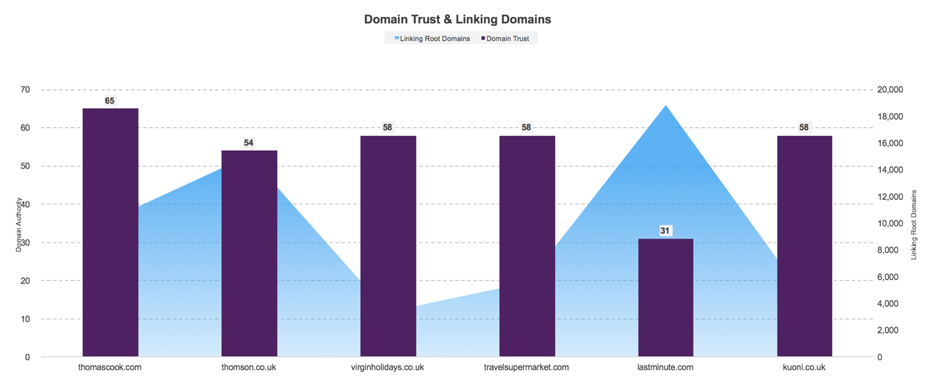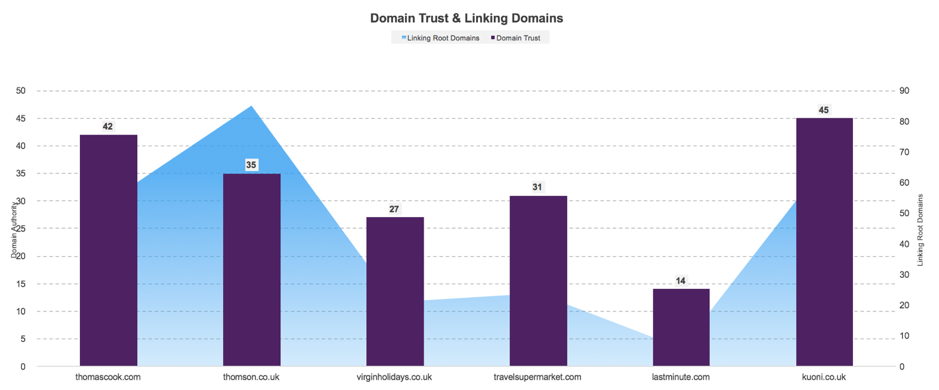Perhaps the reason it intrigues me so much is the huge opportunity to grab traffic from the typical head terms, right through to capturing the long tail search queries at the awareness stage in the buying journey. Alongside this is the challenge smaller brands face competing with the giants in the market and having to get smart with leveraging search.
During this post, I want to take you through an example overview of part of the travel market and give an understanding on how smaller brands are capturing search traffic against the bigger brands in the industry.
The Goliath Challenge
So, Google has a patent in place in regard to brand weighting and how it is calculated. However, it’s pretty difficult to understand.
‘The system determines a site quality score for the particular site, and might be determined by computing a ratio of a numerator and a denominator, where the numerator is based on the count of unique queries that are categorized as ones that refer to the particular site, and where the denominator is based on the count of unique queries that are just associated with the particular site, just don’t refer to it in the same kind of way.’
Perhaps something easier to digest is this piece by Tom Capper over on Moz, around a ranking correlations study which compares domain authority against branded search volume. Basically, bigger brands seem to rank better and have an uplift due to their authority in the market which is certainly a challenge in the travel industry with giants such as Virgin, Thomas Cook and Thomson.
Now I could list at least 20 brands here, but for the purpose of this example I have selected a few that have appeared in a particular SERP that I’m going to be talking about later, with a mixture of big brands, specialists and aggregators.
The scale of this can be seen from a simple bit of keyword research along with monthly volumes:
- Thomas Cook: 1,400,000
- Thomson: 992,000
- Virgin Holidays: 224,000
- Travel Supermarket: 139,000
- Lastminute: 75,000
- Kuoni: 43,000
Market Landscape
I’m sure you all know how to see where you are in comparison to your competitors, with tools such as Sistrix, SEMrush and Searchmetrics allowing you to see your visibility vs. competitors. We prefer to export all of the keywords that each of the brand ranks for, and then categorise, strip out branded terms and then drop it into a graph to give you a visual.
So, for this example we’ve taken a sample set of just over 3,000 keywords, which would equate to just over half a million visits if you were fortunate enough to rank first for them all with conservative CTR assumption.
We then pulled just a few of the brands with visibility for these terms, and below you can see the output:

To summarise this, the higher you are the better your average rank across these terms, and the further to the right means the site ranks for a higher number of terms.
However, looking at a whole market is perhaps a bit too broad, especially with so many locations and resorts, so if you’ve categorised your keywords well you’ll also be able to run graphs for individual categories. Below is an example for Thailand which contains 480 keywords, which again would equate to 69,000 visits, so still a significant amount of traffic:

We can see that Virgin is out in front with a brand presence of more than five times that of the smallest in the list, Kuoni. So how does Kuoni start to compete or even take market share away from all the other brands with pretty much double the awareness?
Let’s take a look…
Links
Like everyone else with any SEO knowledge, I know that it’s not just about number of links. However they are still a very important ranking signal.
Below I’ve simply the taken number of referring domains and domain trust from Majestic and charted this in… you’ve got it, another graph:

When you correlate the size of brand vs. the volume and quality of links then it’s not representative at all, with Kuoni appearing to do well at earning links and having a higher volume at the same quality as Virgin Holidays. This starts to show that if we took the brand weighting out and relied on authority and links, the market landscape would certainly look different.
Next, I’ve looked at links into the key destination landing pages. Interestingly this is a slightly different picture: Virgin Holidays only has nine referring domains and a lower quality of links into its Thailand holiday page and Kuoni has three times the volume of links and significantly more domain trust from those domains.
So more links into the whole domain, individual location directories and a better quality from the smaller brand which is competing against these giants:

Engagement
After looking at links I wanted to understand engagement metrics, and for this I used time on site and bounce rate taken from Alexa. 
Here’s where some of the bigger brands start to excel and should really be a focus for Kuoni. Interestingly, as they are very bespoke holidays, it links off to a subdomain page potentially making bounce rate inflate and time on site decrease, so would benefit from being all on the same subdomain.
Pages indexed
Next I wanted to understand content depth for pages indexed relevant to Thailand on each of the sites.
Here’s how it stacks up (to get the volume simply type site:{url here} inurl:{location}
- Thomas Cook: 18
- Thomson: 579
- Virgin: 136
- Travel Supermarket: 49
- Last Minute: 4,440
- Kuoni: 349
**slight caveat alert: lastminute.com has the most amount of pages indexed for /Thailand/ simply due to its broad hotel offering.
As we saw earlier Kuoni is significantly smaller in terms of overall branded search volume. However, it has the second highest volume of pages ranking for the Thailand keyword set. This shows the brand is making content work hard in order to drive visibility into the keyword set that’s been sampled, and I’m sure if we were to broaden the number of terms then Kuoni would in fact rank for more terms than a lot of the larger brands.
A good example to look at is perhaps its multi-centre holidays. This has a reasonable monthly search volume of 590 searches per month. For this term, it outperforms the competitors looked at in this post, and when you look at the pages in comparison to each other you can see why…
- http://www.kuoni.co.uk/thailand/multi-centres
- https://www.virginholidays.co.uk/destinations/asia-and-far-east/thailand/multi-destination
- http://www.thomson.co.uk/holidays/multi-centre
- https://www.travelsupermarket.com/en-gb/holidays/thailand/pattaya/
- https://www.thomascook.com/holidays/signature/multi-centre/
Not only has Kuoni written more content on the main landing page, it has also created lots of other landing pages surrounding this term for each location (Koh Samui/Chiang Mai/Bangkok etc) + multi centre and along with an internal linking strategy to this content.
Summary…
If you are running the digital strategy for a large brand then you have the ability of exploiting the power of the patent that’s in place for brand weighting in your favour, but don’t rest on your laurels of simply having “the brand” as being enough.
As we have seen, despite this patent, smaller brands still have a huge opportunity to capture traffic through building and creating relevant landing pages and driving authority into deeper pages of the site.
Below I’ve summarised the findings in a simple table. As we have seen Kuoni is managing to compete with the ‘giants’ of the industry when it comes to visibility of specific locations. While we can see that it is only really competing in the ‘site specifics’ on overall domain authority, Kuoni is focusing on driving deeper authority and creating more location specific content on the site to drive location specific visibility.

Despite this relatively small sample keyword set and list of brands analysed, it’s clear to me that between them they all could be driving further awareness visibility through content output. While a lot of them are ranking for ‘I want to know’ micro-moments they are all appearing much further down the SERP for these types of terms.
For example, ‘things to do in Phuket’ delivers an average of 3,600 searches per month giving the Davids of this world an opportunity to capture lots of this traffic, right at the top of the purchase funnel.
For more on this topic, check out these Econsultancy resources:
Comments